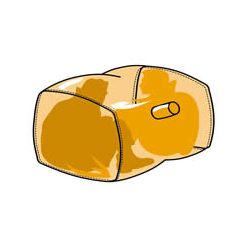Bothy Bags
(Pronouced "BAH thee")In the United Kingdom a bothy is a simple shelter, generally left unlocked and available for anyone to use without charge. Bothies are to be found in remote, mountainous areas. In the U.S. it is often known as a mountain hut.
A Bothy bag is a portable shelter made of waterproof nylon just big enough to accommodate two persons sitting together protected from the harsh environment. Larger ones accommodate 4,6, 8, 12 or more persons.
Unfortunately, bothy bags have not yet caught on in the U.S.
A Bothy Bag is a fabric structure that protects from wind and rain to trap and combine the body heat from several people. By creating a warm local environment bothy provides protection from the threat of hypothermia and wind chill.
Bothy bags are sometimes referred to as a Kisu ( Karrimor Instructor Survival Unit ). They were originally developed by Karrimor. The newer ones are made from lighter fabric and have over the years proved to be extremely effective and carried by an increasing number of people, not just instructors.
Bothy bags are often used for lunch and rest stops where it is simple to pull the bothy bag over your head(s) and enjoy a shelter from the wind, cold and/or rain while eating lunch or just taking a break.
The major manufacturers seem to be mostly in the U.K. Terra Nova, Vango, Outdoor Design and JDS all make 1, 2, 4, 8, 12 and 16 person bags. A typical 2 person bag weighs about 16 oz (500 grams) and take the space of a 1 litre Nalgene bottle. Larger ones only add incrementally to the weight. Bags have air vent(s), plastic window(s), bottom draw-string and integral stuff sack.
Original article: http://www.backpacking-lite.co.uk/lightweight-shelter/bothy%20bags.htm
Even on a normal day in the mountains you can find yourself spending the day in high winds and rain with no natural shelter available. After a while the desire to get out of the wind can become strong. This is where a bothy bag comes into its own.
A bothy bag is a very simple concept. It is nothing more really than a very big waterproof nylon bag. The front usually has one or more windows and the back usually has one or more vents.
Using one is very simple; you take it out of it's pack sack and put it over your head(s). Typically the base of the bag has a drawstring closure that will help stop it flying off. Larger ones may have interior handles.
A bag will typically be made out of 100% waterproof non-breathable nylon and have taped seams. The better ones are effectively frameless tents.
Using a bothy bag will provide you with some warmth and shelter. Condensation may well be a problem but it is assumed that you will carry on wearing all your normal outdoor gear and use them to stay dry.
A one-person bag weighs around 300g and a 4-person bag weighs around 400g. 300g is lighter than most plastic bivy bags and 400g is lighter than almost all single-man bivy bags. For the low-weight and weather protection provided they are an essential part of any autumn/winter pack.
In an emergency situation it would be viable to leave one or more people in one of these shelters (with food and water and clothing etc.) whilst someone else went to fetch help. This is one of of those few times were choosing a bright colour is a good idea for outdoors gear. The storm shelter shown also has a hi-viz cross on the top.
For most people who are going out into the hills a bothy bag and not a bivy bag should be on their emergency essentials list. It weighs less, it packs smaller and is far more versatile.
Jim Yuen last update March 2007
Email Me




